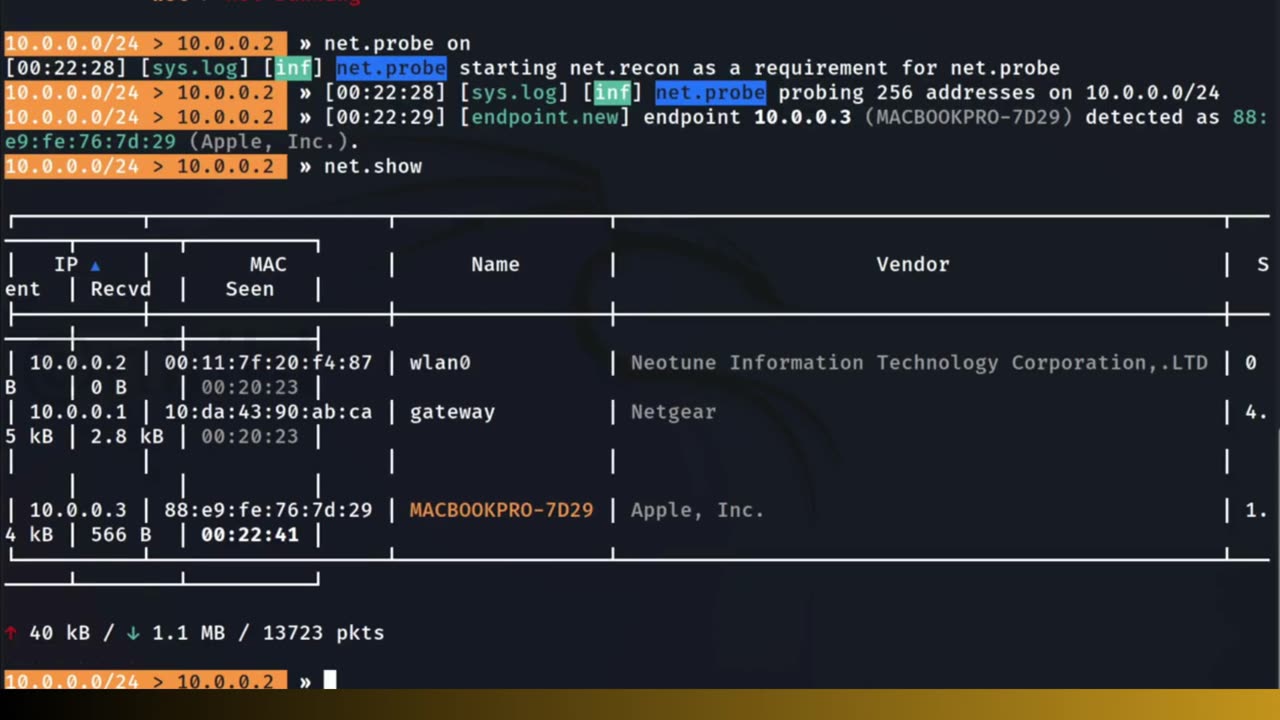Premium Only Content

Cyber Security Tool BETTERCAP | Cyber Security Education | Security Measures in Description
BETTERCAP is a powerful network manipulation and penetration testing tool that is commonly used in Kali Linux, a popular operating system for ethical hacking and security testing.
Bettercap allows security professionals and researchers to perform various network-related activities, such as network sniffing, spoofing, password capturing, and man-in-the-middle attacks.
Here are some key features and capabilities of Bettercap:
Network Sniffing: Bettercap can capture network traffic and analyze it for security analysis purposes. It can intercept and log network packets, allowing you to inspect the contents of the traffic flowing through the network.
Man-in-the-Middle Attacks: Bettercap facilitates man-in-the-middle (MITM) attacks, where it can position itself between a client and a server, intercepting and manipulating the communication between them. This capability is useful for testing the security of network devices, identifying vulnerabilities, and capturing sensitive information.
Password Capturing: Bettercap has the ability to capture login credentials, including usernames and passwords, by sniffing network traffic. This feature can be used to test the security of applications and systems by demonstrating the risk of transmitting sensitive data over unsecured networks.
DNS Spoofing: It can spoof DNS responses, allowing an attacker to redirect network traffic to malicious websites or perform phishing attacks by impersonating legitimate websites. This capability helps in identifying vulnerabilities in network configurations and applications that rely on DNS.
SSL/TLS Stripping: Bettercap can strip SSL/TLS encryption from secure connections, exposing the underlying plaintext traffic. This can be useful for testing the security of applications and services that rely on secure communication protocols.
Web Interface: Bettercap provides a web-based interface that allows users to easily interact with its features and view real-time network traffic and analysis. The web interface provides a user-friendly way to configure and control the tool.
It's important to note that Bettercap should only be used in a legal and ethical manner, with appropriate authorization and consent. It is primarily intended for security professionals, network administrators, and researchers who are responsible for testing and securing their own systems or performing authorized security assessments.
To protect yourself from potential BETTERCAP attacks, consider implementing the following security measures:
Encryption: Use secure protocols such as HTTPS, SSH, and VPNs to encrypt your network traffic. Encryption makes it difficult for attackers to intercept and manipulate your data.
Strong Passwords: Ensure that you use strong, unique passwords for all your accounts. Avoid using easily guessable passwords or reusing passwords across different platforms.
Two-Factor Authentication (2FA): Enable 2FA whenever possible. This adds an extra layer of security by requiring a second verification step, such as a code sent to your mobile device, in addition to your password.
Be Wary of Untrusted Networks: Avoid connecting to untrusted or public Wi-Fi networks, especially for sensitive activities like online banking or accessing personal accounts. If you must use such networks, consider using a VPN for an added layer of encryption.
Regular Software Updates: Keep your operating system, applications, and security software up to date with the latest patches and updates. This helps protect against known vulnerabilities that attackers may exploit.
Firewalls: Configure and maintain firewalls on your network devices and systems. Firewalls act as a barrier between your network and potential threats, helping to block unauthorized access.
Network Monitoring: Regularly monitor your network for any suspicious activity or unexpected behavior. Implement intrusion detection and prevention systems (IDS/IPS) to detect and block potential attacks.
Security Awareness: Educate yourself and your team about common phishing techniques and social engineering attacks. Be cautious when clicking on links or downloading files from untrusted sources.
Disable Unused Services: Disable any unnecessary network services or protocols that you are not using. This reduces the attack surface and minimizes the potential for exploitation.
Regular Security Audits: Conduct regular security audits and penetration testing on your network and systems. This helps identify vulnerabilities and provides an opportunity to address them before they can be exploited.
Remember, while these measures can significantly improve your security posture, it's essential to stay vigilant and informed about the latest security threats and best practices.
-
 18:29
18:29
The Rad Factory
1 day agoBuilding Shred Eighty a Custom Honda Snow Kart
5 -
 UPCOMING
UPCOMING
Precision Rifle Network
1 day agoS4E7 Guns & Grub - What makes group size increase?
218 -
 46:29
46:29
SGT Report
22 hours agoAMERICA IS BACK! BYE BYE IRS!! -- Sam Anthony
37.9K75 -
 8:56:13
8:56:13
Dr Disrespect
11 hours ago🔴LIVE - DR DISRESPECT - WARZONE - 150 PLAYER LOBBIES
154K20 -
 1:27:35
1:27:35
Redacted News
5 hours ago"This is NOT normal" Trump just destroyed the woke mob as Dems in disarray | Redacted News Live
131K252 -
 1:39:52
1:39:52
Vigilant News Network
6 hours agoUNHINGED: Dems Say That Elon Needs to ‘Go Back to AFRICA?’ | The Daily Dose
84.9K19 -
 1:13:13
1:13:13
Sean Unpaved
6 hours ago $6.05 earnedQB Carousel
72.4K2 -
 1:04:28
1:04:28
Crypto Power Hour
1 day ago $5.60 earnedThe Crypto Power Hour - ‘In Crypto We Trust’
74.5K7 -
 28:55
28:55
CatfishedOnline
6 hours agoWoman Love Bombed by Salt-and-Pepper Scammer
42.3K6 -
 14:51
14:51
Misha Petrov
5 hours agoDemocrats HUMILIATED at Trump’s Congressional Address! Breaking Down the MUST-SEE Moments
41.5K32